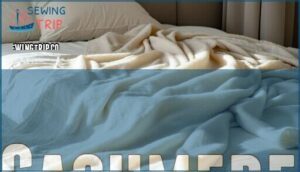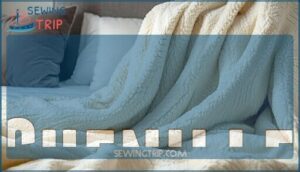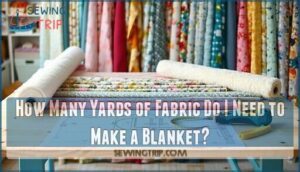This site is supported by our readers. We may earn a commission, at no cost to you, if you purchase through links.
 The softest fabric for blankets includes fleece, cashmere, and high-quality flannel, which provide that cloud-like comfort you’re seeking.
The softest fabric for blankets includes fleece, cashmere, and high-quality flannel, which provide that cloud-like comfort you’re seeking.
Fleece offers synthetic softness that’s easy to care for, while cashmere delivers luxurious natural fibers that feel like butter against your skin.
Flannel, when brushed properly, creates a cozy texture that’s perfect for chilly evenings.
Each material has unique benefits, from fleece’s durability to cashmere’s temperature regulation.
The key is finding what feels right for your comfort preferences and lifestyle needs.
Understanding how these fabrics compare regarding warmth, maintenance, and longevity will help you make the perfect choice for your home.
Table Of Contents
- Key Takeaways
- What is a Blanket Fabric?
- What is The Softest Fabric for Blankets?
- What is The Warmest Fabric for Blankets?
- What Fabric is Used for Baby Blankets?
- How Many Yards of Fabric Do I Need to Make a Blanket?
- What is The Softest Fabric for Baby Blankets?
- Throw Blankets for The Living Room
- Soft Blankets for The Bedroom
- Frequently Asked Questions (FAQs)
- Conclusion
Key Takeaways
- You’ll find that cashmere delivers the ultimate softness with its fine goat fibers, while fleece offers synthetic comfort that’s budget-friendly and easy to care for.
- Your blanket choice should balance softness with practicality—flannel gets softer with each wash, wool provides natural durability and temperature regulation, and chenille creates that plush caterpillar-like texture.
- You can’t go wrong with bamboo or microfiber for baby blankets since they’re hypoallergenic, breathable, and gentle on sensitive skin while remaining machine washable.
- You’ll want to consider your specific needs when choosing—fleece for easy maintenance, cashmere for luxury, flannel for year-round versatility, or wool for long-lasting warmth and fire resistance.
What is a Blanket Fabric?
Blanket fabric definition encompasses the material properties that create your cozy companion for chilly nights.
The best blanket material combines fiber composition with specific weave types to achieve ideal softness and warmth.
Whether you’re choosing cotton, fleece, or wool, each softest blanket fabric offers unique characteristics.
Plush blanket fabric results from factors like thread count, fiber length, and finishing treatments.
The softest fabrics for blankets balance comfort with durability, ensuring your cozy blanket material withstands regular use while maintaining that cloud-like feel against your skin.
This balance is crucial for a blanket to be both comfortable and durable.
What is The Softest Fabric for Blankets?
You’ll discover that fabric softness depends on fiber thickness, weave structure, and finishing treatments that create smooth textures.
The softest blanket materials include fleece, cashmere, flannel, wool, and chenille, each offering different comfort levels based on their unique fiber properties and construction methods, which create a smooth texture.
Fleece
Snuggling into fleece feels like wrapping yourself in a cloud of comfort. This synthetic wonder offers incredible fleece blanket softness while maintaining impressive fleece durability that withstands countless washes.
You’ll love how lightweight fleece weight makes it perfect for year-round use, and fleece blends combine the best of multiple materials. The fleece cost remains budget-friendly compared to natural alternatives, making it accessible for everyone.
For those seeking the ultimate in softness, fleece is often a top choice. Unlike fleece alternatives, this cozy blanket material provides consistent warmth without the hefty price tag, earning its spot among the softest fabrics blankets can offer.
Cashmere
Picture yourself wrapped in pure luxury – that’s what cashmere delivers. This softest fabric comes from the undercoat of Cashmere goats in Central Asia’s high plateaus, making it the ultimate luxury blanket fabric for those who crave unmatched softness.
Here’s why cashmere stands out among blanket materials:
- Exceptional softness – The fine fibers create a velvety texture that feels like a gentle hug
- Lightweight warmth – You’ll stay cozy without feeling weighed down
- Natural breathability – Perfect temperature regulation for year-round comfort
Cashmere sourcing requires careful attention to ethical practices, as quality affects both cashmere durability and performance. You can find a luxury cashmere blanket for ultimate comfort.
While cashmere cost runs higher than other fabrics, proper cashmere care extends its lifespan substantially. If budget’s tight, cashmere alternatives like high-quality fleece offer similar comfort. When you’re ready to invest in blankets that transform your relaxation time, cashmere’s unbeatable combination of luxury and functionality makes every penny worthwhile.
Flannel
Flannel’s reputation as one of the softest fabrics for blankets isn’t just hype—it’s earned through careful craftsmanship.
This cotton fabric undergoes a special brushing process after weaving that creates its signature fuzzy texture and incredible flannel softness.
You’ll love how flannel weave creates that velvety feel against your skin.
The brushed surface traps air, making flannel blankets naturally insulating while remaining breathable.
Unlike heavier materials, flannel weight strikes the perfect balance between coziness and comfort without feeling bulky.
Flannel durability makes it a smart investment for your home.
It withstands regular washing and actually gets softer over time.
The flannel care routine is refreshingly simple—just toss it in cold water on a gentle cycle.
What sets flannel apart from other soft fabrics is its versatility.
You can find flannel blankets in classic plaids, modern prints, or solid colors.
Consider browsing options for flannel softest blankets for a wider selection.
Whether you’re curling up for movie night or adding warmth to your bed, flannel delivers that "wrapped in a warm hug" feeling every time.
Wool
Why does wool remain a favorite among the softest fabrics blankets offer? This natural fiber delivers exceptional wool softness through its fine, dense structure that feels gentle against your skin.
Wool warmth comes from its superior insulation properties, trapping air between fibers to keep you cozy in any weather. You’ll appreciate wool durability since these fibers can bend 20,000 times without breaking, making your blanket a long-term investment.
The fabric naturally resists fire, mildew, and dust mites while managing moisture effectively. For wool care, wash gently in cool water and air dry to maintain softness.
While wool alternatives like fleece exist, nothing matches wool’s combination of natural warmth, breathability, and lasting comfort for blankets.
Chenille
Chenille gets its name from the French word for caterpillar, and you’ll understand why once you feel its fuzzy texture.
This softest fabric creates blankets with incredible softness through chenille weaving techniques that produce thick, plush fibers.
You can find chenille blends made from cotton, wool, or polyester, each offering different levels of chenille durability.
The soft and comfortable feel makes it perfect for cozy evenings. Low-melt nylon is often used as a core yarn in its construction.
Chenille care is simple with gentle machine washing, though chenille cost varies depending on fiber content and quality.
What is The Warmest Fabric for Blankets?
Several blanket materials excel when you’re hunting for maximum heat retention during cold nights.
The warmest softest blanket options combine superior insulation properties with comfort that doesn’t sacrifice coziness for temperature control.
Here are the top 5 warmest blanket materials:
- Wool – Thick wool blankets trap warm air between fibers, creating natural insulation that regulates body temperature while wicking moisture away
- Down – Provides unmatched warmth without heavy fabric weight, compressing easily for storage while maintaining excellent heat retention
- Cashmere – Features extra-fine weave construction that creates exceptional insulation properties, making it breathable yet incredibly warm
- Cotton Fleece – Offers midweight warmth with machine-washable convenience, balancing fabric weight with reliable heat retention
- Silk – Delivers luxury warmth through natural anti-microbial properties while maintaining moderate fabric weight
Climate considerations matter when selecting softest fabric for blankets, as layering options can enhance warmth without overwhelming bulk.
What Fabric is Used for Baby Blankets?
Choosing baby-safe fabrics becomes your top priority when selecting blanket materials for your little one.
Cotton stands out as the most popular choice, offering natural softness and breathability that’s perfect for delicate skin.
Bamboo fabric provides exceptional softness while remaining eco-friendly and hypoallergenic. Muslin’s lightweight weave guarantees comfort without overheating.
For ultimate luxury, minky fleece delivers plush texture that babies love. Merino wool offers temperature regulation with natural hypoallergenic properties, making it ideal for sensitive skin blankets.
| Fabric Type | Key Benefits | Best For |
|---|---|---|
| Cotton | Breathable, affordable, easy care | Everyday use, warm climates |
| Bamboo | Eco-friendly, silky soft, hypoallergenic | Sensitive skin, all seasons |
| Muslin | Lightweight, durable, versatile | Swaddling, summer months |
| Minky Fleece | Ultra-soft, warm, machine washable | Cold weather, comfort |
| Merino Wool | Temperature-regulating, moisture-wicking | Year-round, premium choice |
How Many Yards of Fabric Do I Need to Make a Blanket?
Planning your fabric yardage calculation starts with measuring your desired blanket size carefully.
Most throw blankets need about 2 yards of fabric, while larger adult blankets require 3-4 yards depending on fabric width.
Here’s your essential planning checklist:
- Measure twice – Add seam allowance of 0.5-1 inches to your dimensions
- Check fabric width – Standard 44-inch width may need extra yardage for wider blankets
- Calculate total yards – Divide total length by 36 inches, rounding up
- Consider cost estimation – Budget $2-10 per yard depending on fabric quality
What is The Softest Fabric for Baby Blankets?
When selecting baby blanket fabric, you’ll want materials that prioritize comfort and safety above all else.
Baby skin sensitivity requires gentle, breathable baby blankets made from washable soft fabrics that won’t irritate delicate skin.
| Fabric | Benefits | Care Level |
|---|---|---|
| Organic Cotton | Breathable, hypoallergenic options | Easy wash |
| Minky Fabric | Ultra-soft fibers, plush texture | Machine safe |
| Bamboo Blend | Natural antibacterial, temperature control | Gentle cycle |
The softest fabric choices include organic cotton and minky fabric, both offering hypoallergenic blanket fabric properties.
These materials use safe dyes blankets that won’t harm your little one.
Bamboo blends provide excellent breathability while remaining incredibly soft.
Always choose pre-washed fabrics to prevent shrinkage, and avoid materials with loose fibers that could pose choking hazards.
Your baby’s comfort depends on selecting proven, pediatrician-recommended soft fibers.
Throw Blankets for The Living Room
Comfort becomes the cornerstone of any inviting living space, and throw blankets serve as both functional warmth and stylish living room decor.
You’ll want to think carefully about throw blanket size—most standard throws measure 50×60 inches, perfect for draping over sofas or armchairs. The softest fabric options like fleece, cashmere, or cotton blends provide that cozy factor you’re after while maintaining fabric durability through regular use.
Color coordination plays a huge role in your room’s aesthetic. Choose neutral tones that complement existing furniture, or select seasonal throws to refresh your space throughout the year.
Fleece and microfiber offer exceptional softness without breaking the bank, while cotton throws provide breathable comfort. These throw blankets become conversation starters, literally wrapping your guests in comfortable hospitality while adding textural interest to your living room’s overall design scheme.
Soft Blankets for The Bedroom
Your bedroom deserves blankets that transform sleep into a nightly retreat. The right blanket softness can make all the difference between tossing and turning versus sinking into pure comfort.
Consider these essential elements when selecting cozy blankets for your personal sanctuary:
- Bedroom Blanket Size: Choose oversized throws that drape elegantly over your bed’s edges
- Blanket Color Psychology: Opt for calming blues and soft grays to promote restful sleep
- Blanket Material Blends: Combine cotton-cashmere or bamboo-microfiber for ultimate comfort
- Seasonal Blanket Rotation: Layer lightweight summer throws with heavier winter options
Bedroom Decor Integration matters too—your blankets should complement existing colors and textures.
For those seeking breathable options, consider linen’s moisture-wicking capabilities. Fleece and chenille offer exceptional softness for year-round use, while weighted blankets provide therapeutic comfort.
Don’t underestimate how the right fabric can turn your bedroom into a five-star hotel experience every single night.
Frequently Asked Questions (FAQs)
What fabric makes the softest blanket?
Smooth as silk" rings true, but you’ll find cashmere takes the crown for ultimate softness.
Its fine goat fibers create unmatched luxury.
Bamboo and microfiber offer affordable alternatives that feel incredibly gentle against your skin, providing a softness that is hard to match.
What is the softest fabric for bedding?
You’ll find bamboo and microfiber offer exceptional softness for bedding.
Bamboo’s naturally smooth fibers feel silkier than Egyptian cotton, while microfiber’s ultra-fine construction creates cloud-like comfort that’s both affordable and easy to maintain.
What type of fabric is best for blankets?
You’ll want to choose based on your needs.
Bamboo offers breathability and hypoallergenic properties, while fleece provides warmth and affordability.
Cotton delivers versatility, and cashmere brings luxury—though it’s pricier than other options.
What is the softest fabric to sleep in?
While rough textures can irritate your skin, bamboo fabric feels like sleeping on a cloud.
You’ll love how it’s softer than Egyptian cotton, naturally breathable, and hypoallergenic—perfect for sensitive skin and year-round comfort.
What is the best way to care for a soft blanket?
Wash your soft blanket in cold water using gentle cycle and mild detergent.
Air dry or use low heat to prevent fiber damage.
Store in breathable bags and fluff regularly to maintain that cozy softness you love.
Are there any hypoallergenic fabrics for blankets?
Yes, you’ll find several hypoallergenic blanket fabrics that won’t trigger allergies.
Bamboo, microfiber, and cotton are naturally resistant to dust mites and bacteria.
Synthetic materials like fleece also repel allergens effectively, making them a good choice for those with allergies, and are naturally resistant.
How do you choose the right size blanket for a bed?
Measure your mattress dimensions first, then add 10-15 inches to each side for proper overhang. Twin beds need 66×90 blankets, while king beds require 108×90 sizes for comfortable coverage.
Are there any special fabrics for outdoor blankets?
Like choosing armor for battle, outdoor blankets need special protection.
You’ll want polyester or vinyl-backed fabrics that resist water and dirt.
These materials won’t absorb moisture, dry quickly, and handle rough surfaces without tearing easily, making them ideal for outdoor use with vinyl-backed fabrics.
What is the most durable fabric for blankets?
Wool stands as your most durable blanket fabric choice.
It’s naturally fire-resistant, long-lasting, and handles wear beautifully.
While heavier and pricier than synthetics, wool blankets can last decades with proper care.
How do I maintain blanket softness over time?
Treat your blanket like a treasured friend who needs gentle care.
Wash in cold water with mild detergent, use low heat or air dry, and fluff regularly to keep those cozy fibers happy.
Conclusion
Finding the perfect blanket is like discovering your personal comfort sanctuary.
When considering what’s the softest fabric for blankets, you’ll find fleece, cashmere, flannel, wool, and chenille each offer unique benefits.
Your choice depends on your specific needs—whether you prioritize easy maintenance, luxurious feel, or temperature regulation.
Consider your budget, care preferences, and desired warmth level.
The softest fabric for your blankets ultimately comes down to what feels best against your skin and fits your lifestyle perfectly.

















